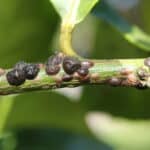Peace Lily (Spathiophyllum spp.) is a perennial plant incorporating dark green glossy leaves and white, showy flowers.
However, different anomalies in its care conditions may lead to the browning of flowers and foliage.
Discover why your Peace Lily is turning brown and how you can help them survive.
Table of Contents Show
Is It Normal For Peace Lily to Turn Brown?
If the reason is old age, it is normal for the Peace Lily to turn brown.
But, if the plant is browning when young, it could signify a much graver problem.
In the case of a Peace Lily flower, it is normal for them to fade and turn brown in their nearing end.
What Causes Peace Lilies to Turn Brown?
Problems like bacterial infections from improper humidity require immediate action to avoid unpleasant events.

Regardless of the severity, Peace Lily can be revived if intervened promptly with the right solution.
Therefore, let us look at the culprits for Peace Lily turning brown.
1. Watering Issues
As Peace Lily prefers moist but not soggy soil, watering Peace Lily once the top soil layer dries out would be ideal.
However, letting the plant wilt too much from dehydration causes premature Peace Lily flowers to turn brown.
Similarly, too much water in the soil invites root rotting problems, resulting in brown leaves and stems.
Solutions
- If more than 50% of the leaves have turned brown, you can snip them off and repot them in fresh soil.
- Place the pot in a location with abundant light and heat.
- Inspect roots for potential rottings, prune off if present, and apply fungicides to cut ends.

- For severely dehydrated plants, run water on the plant a few times till the water oozes out from drainage holes.
- Submerge the plant pot in the water until the air bubble stops forming.
2. Improper Lighting
Long exposure to bright sunlight can cause sunburn forming brown edges on the Peace Lily leaves.
Consequently, keeping Peace Lily in low light will cause no blossoms, and intense darkness can halt the plant’s growth.
Furthermore, light deprivation induces chlorosis in the plant, causing the color to fade in the leaf.
I have mentioned some other symptoms your Peace Lily may exhibit upon poor lighting.
| Lack of Light | Excessive Light |
|---|---|
| Wilting of the plant | The plant's natural photoperiod will be disturbed |
| The plant will be leggy, and the stems will be etiolated | Your Peace Lily will look dull and pale |
| The plant will lose its color, and the patterns will fade | The leaf tips will burn and be scorched with brown edges |
Solutions
- Relocate your plant to at least 5 to 6 feet from the window. Use sheer curtains or drapes to reduce the light intensity.
- Cut off the leaves that have turned brown using sterilized pruners.
- Ensure to use artificial grow lights for almost 12 to 16 hours to compensate for the absence of light.
- Do not place your plant in direct sunlight, even during the winter.
- Find a place where the sun shines indirectly for almost 2 to 6 hours.
Although not all, some Peace Lily owners prefer to keep their plants in slight darkness to encourage better foliage growth while compensating for blossoms.
In contrast, many place Peace Lily plants in indirect sunlight to encourage blossoms with a showy white flower.
3. Overfertilization Issues
You should feed the Peace lily with a balanced fertilizer every two months during the active growth.
However, when Peace Lily is overfed with fertilizer, salt build-ups in the soil will cause browning leaves.
Generally, too much fertilizer causes the nutrients to stockpile, making the soil toxic for plants.
You can easily notice these salt formations with whitish powder-like on the topsoil layer.
Besides brown spots on leaves, flower color also slightly receives a green tint instead of creamy white around the gills from overfertilization.
Moreover, the main fertilizer nutrient that causes Peace Lily to turn brown is excess nitrogen.
Fixing Over Fertilization Issues
- Remove the salt build-ups with the help of a controlled water stream.
- Inspect the plant for any potential root burn; if the burn is severe, consider repotting your plant after removing all damaged roots.
- Resort to Osmocote 14-14-14 or Nutricote 13-13-13 to neutralize the excessive salt build-ups.
- Opt for organic foods for your plant with low chemical burn risk.
If you notice intense dark green foliage development, immediately change your fertilizer and use Potassium enriched fertilizer.
Although Peace Lily does not go through dormancy, do not fertilize your Peace Lily during the winter season.
4. Temperature Stress and Low Humidity
Peace Lily prefers to stay warm (60 and 80°F) at a moderate indoor humidity of 50 to 60%.
If the humidity is too low, you can observe the formation of brown tips and edges of the leaves.
Furthermore, Peace Lily can withstand cold till 55°F but not anything below, inducing temperature stress.

Generally, the humidity is low near the heating appliances, and keeping plants around them causes humidity issues.
Solutions
- Mist your plant and place the plant pot over the pebble tray that is partially filled up with water to maintain the humidity level.
- Make use of transparent plastics to mimic a mini greenhouse with optimum humidity.
- Use heating pads underneath the plant pot or frost blankets to preserve plant temperature.
- Place your plant a couple of feet under the incandescent grow lamp to provide both light and warmth during winter.
- Increase watering frequency during the intensely hot summer seasons.
5. Pests Infestation
Some common pests that can invade your Peace Lily are Spider mites, Mealybugs, and Scales.
These pests suck up the nutrients from the plant, causing the premature browning of Peace Lily flowers and leaves.
As these pests feast on the nutrients of plants, their excessive invasion can halt plant growth with severely disarrayed brown foliage.
I have mentioned the signs and symptoms of pest infestations on Peace Lily.
| Pests | Signs and Symptoms |
|---|---|
 Spider Mites | Tiny yellow-orange with two dark spots Webbings develop under leaves Leaf drooping, wilting, and brown spots |
 Mealy Bugs | White, fuzzy, cottony masses Stunted plant, yellow leaves |
 Scales | Cottony, cushion-like insects Leaf drop, blemishes on leaves |
Treatment Measures
- Immediately isolate or discard the infected plant to halt further spreading.
- Trim off severely infected parts of the plant by using sterilized pruning tools.
- Use alcohol or dish soap on the plant foliage to discourage pests.
- Place yellow sticky traps around the plant to capture invaders and apply neem oil.
- If nothing above seems to have an effect, try using Malathion or Pyrethrin spray as a final resort.
6. Fungal and Bacterial Diseases
Botrytis Blight, Ringspot virus, and Southern Blight are common diseases that Peace Lily are more prone to get affected, causing brown spots on flowers and leaves.
Therefore, keep your eye on early-stage signs of brown or yellow spots, wilting, and black veins on leaves.
Other than wilting and browning flowers and leaves, a fungal disease also results in root rot and stem decay.
Here is a table with brief information about common diseases and their symptoms.
| Common Diseases | Causative Agent | Symptoms |
|---|---|---|
| Botrytis Blight | Botrytis elliptica and Botrytis cinerea | Oval-shaped reddish or brown spots on flower buds and leaves. |
| Bacterial Leaf Spot | Pseudomonas cichorii, Xanthomonas | Appear as black, tan, or dark brown small spots that may have a yellow halo |
| Ringspot Virus | Ringspot Virus | Brown areas on the leaves |
| Southern Blight | Sclerotium rolfsii | White fungal strands can be seen on soil surface and plant stem. |
| Pythium Root rot disease | Phytophthora and Pythium | Plant wilt even when soil is well soaked. |
| Cylindrocladium Root rot | Cylindrocladium spathiphyllum | A soft, brown root that eventually dies. |
| Septoria Leaf Spot | Septoria lycopersici | Formation of brown spots on flowers. |
Treatment Measures
- Prune off the infected parts of the plant and carefully discard them by burying them almost a foot down.
- Spray neem oil and baking soda solution on the leaves where visible signs appear.
- Apply fungicides rich in copper, benomyl, and sulfur to control many fungal infections effectively.
- Agri-Mycin helps to control and treat several fungal infestations as well.
- Consider placing the infected plant in a less humid place and cut back on watering.
Note: Fungal infections like blights, leaf spots, and ringspot virus do not have hard and fast methods to treat them. Therefore, opt for preventive measures before your plant gets it.
Should I Cut off Peace Lily Leaves with Brown Tips?
Although pruning off all damaged or brown parts of the plant sounds best, you may overlook the slightly brown leaf to heal itself.
Here are some tips on properly cutting off brown Peace Lily.
- Using sterilized pruners, prune off leaves and flowers that have gone completely or partially brown.
- If you notice any stems turning brown, cut them at the nearest node to encourage healthy growth.
- Make clean cuts at a 45° angle every time to encourage better growth.
- Bury the plant residues to prevent any potential spreading.
- Thoroughly water your plant after chopping off damaged or decaying parts of the plant to help them revive.
From Editorial Team
Conclusion!
Peace Lily turning brown might be an initial sign of a serious issue, so it is best to find what’s causing them to turn brown.
Thoroughly analyze and grasp the condition of your Peace Lily and then only opt for solutions, as I have mentioned above.
Happy Gardening!!!
